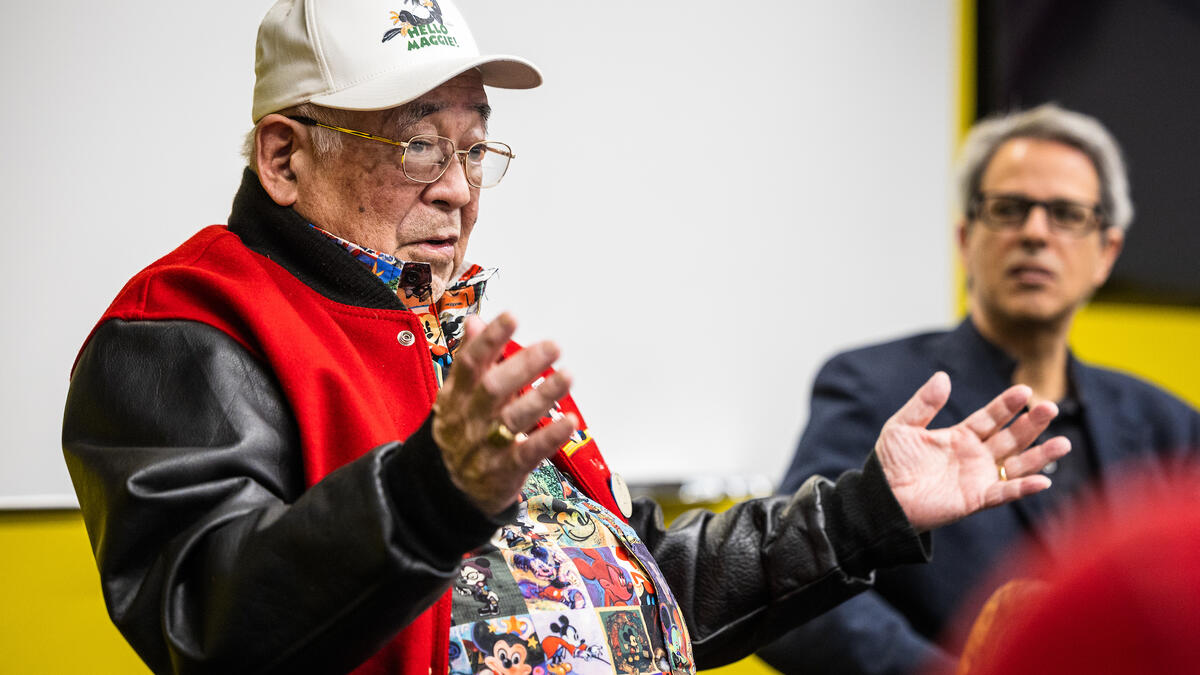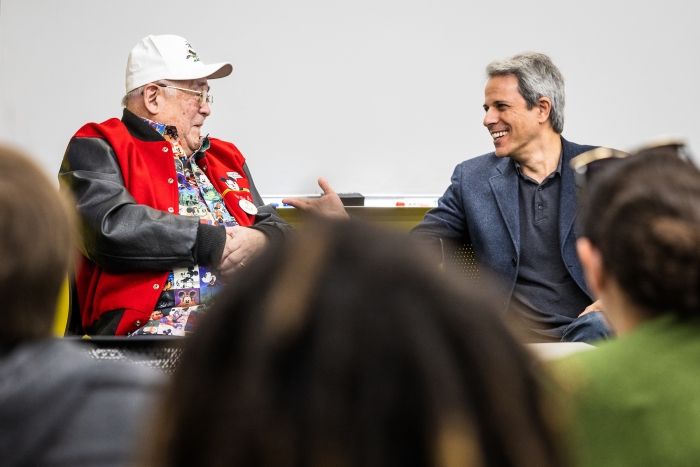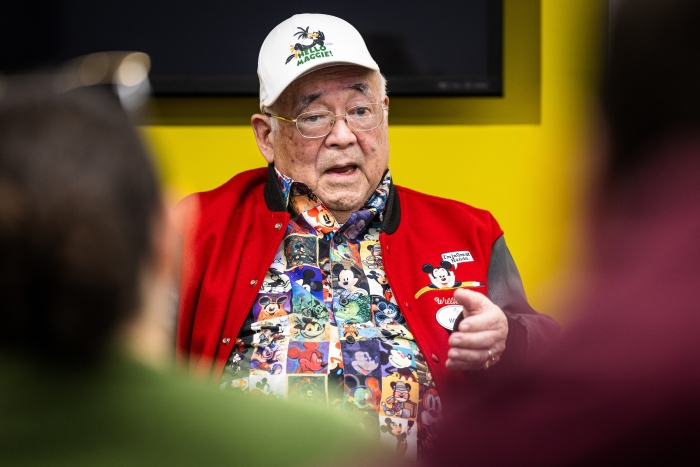An animated life: Disney artist and illustrator Willie Ito visits ASU class

Former Walt Disney Animation Studios, Warner Bros. Cartoons and Hanna-Barbera Productions animator Willie Ito talks with ASU Associate Professor Kevin Sandler in his film and media studies class on Jan. 25 in Durham Hall on the Tempe campus. Photo by Charlie Leight/ASU News
Through dozens of classic Hollywood cartoons and children’s television shows, Willie Ito’s work in animation has charmed millions across the globe and over several generations.
But what many don’t know is that his art was forged and steeled in a World War II Japanese internment camp set in the middle of the Utah desert. His three-year incarceration, starting at the age of 8, turned out to be a creative outlet for his burgeoning talent and helped shaped the way he viewed the world.
“I’m not what you would have called a ‘jock.’ While most of my friends were outside playing on the sandlot, running around and getting into mischief, I chose to stay in and draw to pass the time,” said Ito, who was a guest speaker at an animation history class at Arizona State University’s Tempe campus, speaking to approximately 30 students on Thursday.
“I was very inspired, hoping that one day I might get into the animation business. I stuck to that, and thankfully it worked out just fine,” he said.
Ito was there by invitation, courtesy of Kevin Sandler, an associate professor in ASU’s Film and Media Studies program, for his class "Scooby-Doo and TV Animation."
Sandler interviewed Ito extensively for his upcoming book “Scooby-Doo, Where Are You!” (Duke University Press) about the beloved animated series that debuted in September 1969.
“Willie Ito is one of the oldest living animators from the Golden Age of Hollywood, having worked on Walt Disney’s ‘Lady and Tramp’ as well as several Looney Tunes cartoons, including ‘One Froggy Evening’ and ‘What’s Opera, Doc?’" Sandler said. “He followed that career into television, having worked for over a decade at Hanna-Barbera, the home of ‘The Flintstones,’ ‘The Jetsons’ and ‘Scooby-Doo, Where Are You!’"
While the Thursday event was strictly for students, the public will also get the opportunity to hear Ito talk about his experience in animation, view a display of his art and buy signed prints of his work as well as his illustrated book, “Hello Maggie!” — which he co-authored with Shigera Yabu in 2007.
“A Visit with Willie Ito” takes place from 10–11 a.m. Saturday, Jan. 27, at the Burton Barr Central Library in Phoenix. He’ll also deliver an artist's talk later in the day at the Japanese Friendship Garden in Phoenix.
Ito gave students a firsthand account of Hollywood history, dating back to the 1950s. He said he was studying animation at San Francisco City College when he visited Los Angeles in 1954 to check out the Chouinard Art Institute, where he would continue his studies. While there, Ito thought he’d apply for a job at Walt Disney Studios in nearby Burbank.
“I was 5 years old when I first saw 'Snow White and the Seven Dwarfs,' and I was mesmerized,” said Ito, who is currently a resident of Monterey Park, California. “Seeing those little men march across the screen and singing made me want to become an animated cartoonist. I couldn’t believe I was applying for a job at the studio who created the animated film that changed my life. I went in there with my student portfolio, and it weighed a ton. It was purely unprofessional.”
Watch
Willie Ito talks about his new short film, based on his book “Hello Maggie,” on Arizona PBS' "Horizon."
Ito was shocked when Walt Disney himself stepped into the elevator and they rode up together to the fourth floor.
“He was with another associate, and they were deep in conversation when finally, Walt sees me in the very corner of the elevator and gives me a polite nod. Then they both go back to their conversation,” Ito said. “We get to the fourth floor, and Walt and his associate go to the right and I go to the left for my interview.”
He didn’t think he’d get the job after one of the two men who interviewed told Ito, “Don’t call us — we’ll call you.”
Two weeks later, Ito received a Western Union telegram informing him that he was a Disney employee. His first assignment: the iconic kissing scene between a cocker spaniel and a stray terrier-mix in “Lady and the Tramp.” The $4 million movie debuted on June 22, 1955, and was re-released again in theaters in 1962, 1972, 1980 and 1986, earning nearly $93.6 million in its lifetime, according to IMDB.com.
Ito said although he enjoyed working at Disney, the job was labor intensive and tedious.
“This was when animation was still being traced on acetate cells,” Ito said. “We had an entire department of animators intricately tracing drawings and, later, applying colors. It was such a tedious process. That’s the reason why Disney features back then would take upwards (of) six, seven years in production.”
After several years, Ito went to work for Warner Bros. Cartoons under the direction of Chuck Jones.
He quickly discovered that television had time and budget constraints that the big screen never had, forcing TV producers to make a product at a fraction of the price of theatrical cartoons.
“For ‘Lady and the Tramp,’ if I came up with eight drawings a day, I was on target,” Ito said. “My first day at Warner Bros. was for ‘Speedy Gonzalez,’ and I did 13 drawings and was proud of myself. Then I found out our quota for the day was 30 drawings.”
Ito also worked for Hanna-Barbera in the 1960s, putting his touch on “The Jetsons,” “The Flintstones,” “The Yogi Bear Show” and “Scooby-Doo, Where Are You!”
While he started to make good money, he often worked late into the night and suffered from “animation burnout.” He decided to become an independent contractor in 1977 and set up his own shop. But no one came through his doors or commissioned him to do any work.
When Disney called him with a solid job offer, it was a no-brainer. He shuttered his office and went to work on a syndicated comic strip. The job didn’t last very long. The cartoon industry went on strike in the summer of 1979 to protest film companies sending work to foreign locales such as Korea, Taiwan and Spain.
“Newspapers had to re-run our old comic strips during the strike, and finally they just dropped it,” Ito said. “So that was the demise of the comic strip department.”
But Disney kept Ito on, asking him to help design a line of merchandise and limited-edition collectibles. That venture was successful. The first Disney Store launched in Glendale, California, on March 28, 1987, to a rousing success. At its peak in 2001, there were approximately 700 storesToday, approximately 300 Disney Stores are still in existence. worldwide.
Ito retired from Disney in 1999. He wanted to travel the world with his wife after working nonstop for almost 45 years. But then Ito received a phone call from Yabu, an old friend from San Francisco who also was incarcerated in a camp in his youth. He had just finished a children’s book and felt that Ito was the perfect artist to illustrate his work.
Jan. 27 public talks with Willie Ito
“A Visit with Willie Ito”
10–11 a.m.
Burton Barr Central Library, Phoenix
Artist's talk
1:30–2:30 p.m.
Japanese Friendship Garden, Phoenix
“After 50 years of drawing, I was burned out,” Ito said. “But Shigera was insistent. I finally said, ‘OK, send me the manuscript.’”
The true story revolved around Yabu’s family, who were sent to Heart Mountain Relocation Center in Powell, Wyoming, along with about 10,000 other detainees. Yabu, who missed his pets in San Francisco, eventually develops a friendship with a magpie bird, whom he names “Maggie.”
Ito loved the story and recognized it was his story, too. Together they self-published the book in 2007. The book is now in development as a 22-minute 2D animation film and will be released in July, Ito said.
Animation major Gabriela Portillo sat mesmerized in the front row for Ito’s 90-minute talk and called him a “captivating storyteller.”
“Everything he said takes me back to my roots because 2D animation was my first love and what got me into animation,” said Portillo, who will graduate in May from ASU’s Herberger Institute for Design and the Arts. “‘Lady and the Tramp’ was one of my favorite movies growing up, and it was really an honor to get to hear him talk.”
Jonathan Phan, an anthropology major who is minoring in film and Asian studies, said he was inspired by Ito’s visit.
“It was really impactful and cool to see not just an animation icon but an Asian American who talked about his identity and how it intersected with his career,” Phan said.
More Arts, humanities and education

ASU instructor’s debut novel becomes a bestseller on Amazon
Desiree Prieto Groft’s newly released novel "Girl, Unemployed" focuses on women and work — a subject close to Groft’s heart.“I have always been obsessed with women and jobs,” said Groft, a writing…

‘It all started at ASU’: Football player, theater alum makes the big screen
For filmmaker Ben Fritz, everything is about connection, relationships and overcoming expectations. “It’s about seeing people beyond how they see themselves,” he said. “When you create a space…

Lost languages mean lost cultures
By Alyssa Arns and Kristen LaRue-SandlerWhat if your language disappeared?Over the span of human existence, civilizations have come and gone. For many, the absence of written records means we know…



